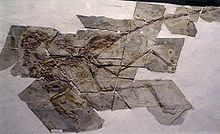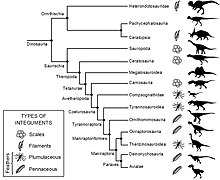Feathered dinosaurs
Since the first discovery of the Archeopteryx in Solnhofen limestone in 1861, there has been evidence that the birds emerged from dinosaurs. However, until a few years ago, other fossils that show this development were extremely rare. It was not until the 1990s that the fossil record in the evolutionary line from theropod dinosaurs to birds was enriched by a series of finds of feathered dinosaurs and early birds in the People's Republic of China .
The primeval bird Archeopteryx is a mosaic of features of both dinosaurs and birds. The dinosaur features include, for example, the long tail, the dinosaur-like chest girdle, the toothed jaws or the abdominal ribs . The wings with the feathers are typical for birds , but also the legs with a special joint, the intertarsal joint , in the tarsus. This feature structure confirmed the assumption about the descent of the birds from the dinosaurs and thus represented an essential piece of evidence for Charles Darwin's theory of evolution, which was only three years old at the time . Archeopteryx , however, remained the only animal that represented a connection between birds and dinosaurs and so on Many theories, especially about the development of flight and the springs designed for it, remained unproven.
Archeopteryx already had feathers that corresponded in structure and function to the feathers of today's birds. These so-called contour springs consist of a central shaft from which smaller side branches branch off. These twigs are hooked together and thus receive stability. In addition, they are asymmetrical and, together with neighboring springs, form a wing that becomes impermeable to air on impact and permeable to air on impact. Since the wings of the Archeopteryx were also constructed in this way, there is broad consensus today about the ability of this ancient bird to fly. How and whether these feathers could have developed from reptile scales, however, has so far only been the subject of speculation. See also: evolution of the bird's feather .

In 1996, researchers found a fossil in the sediments of the Jehol Group in the Chinese province of Liaoning , which would mark the beginning of a series of spectacular discoveries. This dinosaur fossil, a theropod named Sinosauropteryx , had a contour of filamentous structures. Later fossils from the same region such as Caudipteryx , Sinornithosaurus and especially Beipiaosaurus showed similar body-enveloping fibers, which later turned out to be down-like structures made of several filaments with a common point of origin. In addition, elements with a central shaft and symmetrically arranged secondary branches were also found, especially on the forelegs and tail. However, these springs lacked reinforcement. Accordingly, they could not be used as flight instruments, they probably served more to insulate the body from heat. Based on finds of the Oviraptor in a clear breeding position on a clutch, it was already known that this group of dinosaurs must have been warm. An insulating spring layer confirms this assumption.
This does not fully explain the evolution of feathers and bird flight , but the gaps have become much smaller than they were before 1996. But the Chinese fossils also have something to offer for understanding the further evolution of birds to their modern representatives. At the beginning of 2001, the discovery of a bird fossil named Apsaravis was reported in the journal Nature . Since the ichthyornis was found in 1870, no such close relative of recent birds has been found.
Dissenting opinions
Some American paleornithologists, such as Alan Feduccia, interpret the relationships between birds and dinosaurs differently; they believe that the birds split off from the archosaurs before the dinosaurs .
So did Archeopteryx had contour feathers already 150 million years ago as today's birds, some much later species of theropods as Caudipteryx or PROTARCHAEOPTERYX are believed to be ancestors of birds, but would have had much more primitive feathers. This can be better explained by the fact that these alleged theropods are descendants of flightless birds, for which they coined the expression "non-bird dinosaurs".
Her study from 2005 came to the conclusion that the fibers that envelop the body, which some of the theropods found in the Jehol group have, are not feathers, but rather connective tissue in the form of collagen fibers.
Finally, they object that the theropod's fingers developed from fingers I – III, whereas in birds they developed from fingers II – IV.
The majority of paleontologists do not share Feduccia's view.
Web links
- Nadja Podbregar: Dispute over Archeopteryx and Co. - In search of the "missing link" between dinosaurs and birds. on: scinexx.de (as of August 13, 2010)
- Carl Zimmer : How nature invented the feather. on: Spiegel online . Published on February 6, 2011
- Archeopteryx, ancient birds, and dinosaur-bird relationships. ( Memento from November 25, 2011 in the Internet Archive )
- Stephen Czerkas: Are Birds Really Dinosaurs? Essay. (PDF; 3.43 MB)
- Sensational find in China: New dinosaur could probably fly. In: chip.de . May 2, 2017 (according to Nature ). Name: "Jianianhualong tengi"
literature
- Z. Zhou: The origin and early evolution of birds: discoveries, disputes and perspectives from fossil evidence. In: Natural Sciences. 91, 2004, pp. 455-471. ( Full text ; PDF; 396 kB).
